Diver Driver
First Experiences as a Jump Pilot
Page 1 of 2
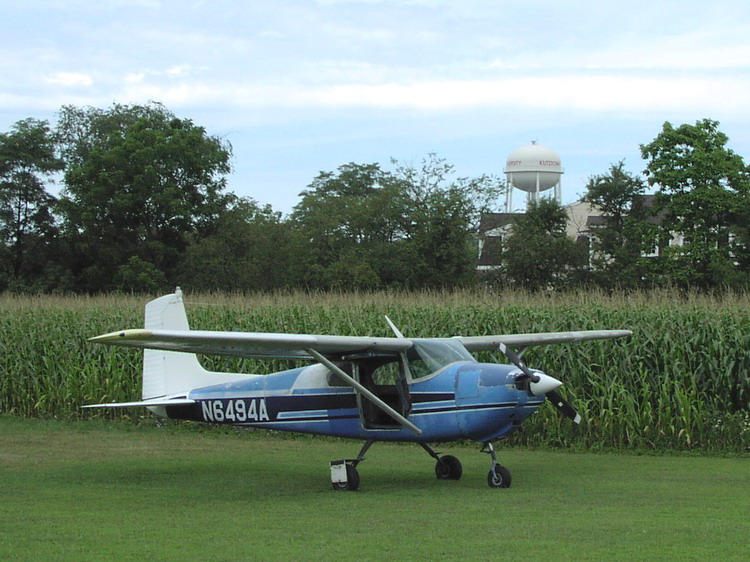
My weekend office as a jump pilot in Kutztown, PA, Summer
2005
Part of the Community
In 2004 I made my first tandem skydive at a local dropzone. I followed that skydive up with a few more tandems, some additional ground training, and then my first Accelerated Freefall (AFF) jump with a single instructor. As I flared the canopy on that jump to a stand-up landing, I let out a "Wahhoooo!" and realized at that moment that I'd officially become part of the skydiving community. The remaining weekends of the season were unsuitable for student jumps, so I figured I'd continue to acquire flight time for my Airline Transport Pilot's license and pick up jumping again once the ATP was a done deal.
One day early this season I received a postcard in the mail announcing that a dropzone called Sky's The Limit had relocated from Newton, NJ to nearby East Stroudsburg, PA. I didn't know much about the dropzone but after a quick visit to their website it soon became clear that they had access to some serious jump aircraft, including a Cessna 208B Caravan.
My jump partner Todd had been working steadily on his A-license (the initial USPA-sanctioned skydiving license) over the last several months. Convinced that Sky's The Limit would be able to provide enough seats to accelerate his pursuit of the license and expose us both to the unique culture of a large dropzone, one weekend in early July we decided to fly the 172 up to the Stroudsburg Pocono Airport to check things out.
First Visit
We arrived at East Stroudsburg to find a small airport nestled in a valley just north of the scenic Delaware Water Gap. The narrow runway caught me a bit by surprise, but I managed to adjust my flare height to compensate for the illusion that we were higher above the runway than normal. We taxiied in to find lots of people in jumpsuits milling about, and a large open hangar.
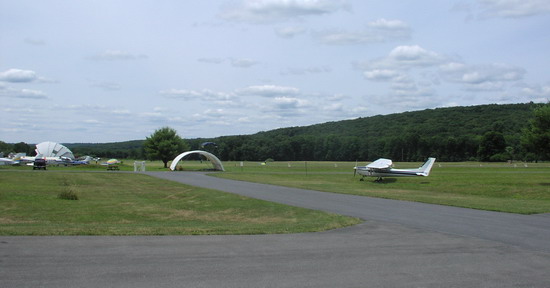 After we parked the 172 on a nearby ramp and
walked up to the hangar, we saw the manifest office and heard a
woman announce "15 minute call to Caravan Load 3" and a long list
of names. And I mean a LONG list of names. While the 182 can hold
a handful of skydivers, the Caravan was obviously an entirely
different beast -- and one serious skydiving machine.
After we parked the 172 on a nearby ramp and
walked up to the hangar, we saw the manifest office and heard a
woman announce "15 minute call to Caravan Load 3" and a long list
of names. And I mean a LONG list of names. While the 182 can hold
a handful of skydivers, the Caravan was obviously an entirely
different beast -- and one serious skydiving machine.
We spent a few minutes talking to manifest about jumping, prices, and the general operation, and were eventually introduced to the dropzone owner (DZO). I introduced myself as a pilot and fledgling skydiver, and asked a few questions about the Caravan. Frankly, at the time I was more interested in what it could do for me as a skydiver and less concerned about its flying characteristics, but I naturally asked a few "pilot" type questions as well.
As we were talking, we watched the Caravan pilot finish up refueling, fire up the airplane, run it over to a group of about 15 waiting skydivers, and take off in less than 3 minutes. My friend and I complemented the DZO on a fine operation and told him we'd be back to jump. I added that if he was looking for pilots to fly the Caravan, I'd be interested in some part time work next season and handed him my card.
A Chance Opportunity
About a week later, I received a call from the dropzone owner while I was at the office grinding through some code. He told me that some things had changed, and he needed a jump pilot sooner than expected. We spent some time discussing his needs and my schedule, and we ultimately agreed to meet at the dropzone the following weekend to discuss things in greater detail.
During the meeting we discussed my piloting experience, the fact that I was within a few hours of the magical 1500 hour mark required for the ATP, my immediate plans to get my ATP, and my long-term plans to start flying more complex and turbine aircraft to both maintain and enhance my piloting skills. I joked, "I'm falling asleep flying bug smashers...I need some excitement".
Because neither of us really had anything to lose at this point, the discussion was refreshingly open and frank. We talked about the rigors of flying commercially, including flying when the customer wanted to fly and with sometimes less than perfect equipment and weather. We had established during our initial negotiations that while I had more than enough piloting time for the task, I lacked experience flying jumpers, so we agreed that I'd need to gain some before I could transition to the "big time" flying the Caravan.
The DZO was also in the business of leasing his aircraft out to other dropzones when the need arose, including, as luck would have it, a small dropzone in nearby Kutztown, PA. He recently lost his 182 pilot that was serving that DZ, and needed to train me anyway, so we agreed that I'd fly the 182 there until I reached a certain comfort level flying jumpers.
Student Jump Pilot
Not long after our conversation, we arranged to do my initial training. At this point I wasn't so much concerned with my ability to fly the aircraft as how I would manage to learn the special flying techniques and radio phraseology required by jump operations. I couldn't help but feel a bit like a student pilot again.
While flying precisely by reference to instruments is second nature at this point, the only IFR I'd be doing in this sparsely equipped 182 was "I follow Roads". Jump pilots fly the aircraft primarily by ground reference....which doesn't sound difficult until you realize that climbing above one or more scattered cloud decks up to 10000+ feet often doesn't leave much of the ground visible. And the whole point of jump operations is to get the jumpers to maximum altitude and navigate the aircraft to within a couple tenths of a mile (at most) of a specific location relative to the dropzone called the "spot". Accuracy is important here, because without it jumpers will be forced to land off airport. So, when was the last time you tried to do turns about a point at 10000 feet? Above the clouds? Accurately? Yea. Me too.
Fortunately, I had a few things going for me. First, most of my piloting time was in Cessnas, so flying the 1956 182 wouldn't present that much of a basic piloting challenge. I also had a fair amount of aerobatics and glider experience so my ability to precisely control an aircraft in all axes had long ago been demonstrated. And I figured my aircraft operating and maintenance experience would help convince the owner that I would know how to treat his aircraft with the proper respect, particularly during the rapid descents required in jump operations. New cylinders aren't cheap.
My greatest concern was whether I had the physical stamina to fly jumpers. This ain't cruise flight and there's no autopilot that will do what a jump pilot needs to do. You don't really get to take a deep breath and relax at any point. It takes physical and emotional strength to fly load after load, all day long, with few if any breaks, while doing it consistently and SAFELY. The DZO warned me that I'd need to fly the aircraft in a way that covers all the killer items on each and every load, because you won't screw up when you're fresh -- you'll do it at the end of the day, when you're very tired and a couple loads past your comfort zone. Words to live by in any aircraft operation, private or commercial. Needless to say, I took them to heart.
Sim Time
Jump aircraft normally have all seats but the pilot's removed, so the DZO had to reinstall the right seat in the 182 before we took off for some basic airwork. We took off and went through the usual 4 fundamentals and a stall series. He seemed most interested in my ability to fly the aircraft slowly -- indeed well into the stall -- and maintain control. Easy enough. The 182 flew about as predictably as a Cessna should. The first thing I noticed is that the square-back tail made the rudder far more effective than that on our 172, so I had to be a bit more aware of rudder input when deep into the stall. I also noticed that the 182 seemed to be nicely harmonized in roll and appeared to require far less rudder input to counteract adverse aileron yaw. Airwork done, we flew back to the pattern for some basic takeoffs and landings which went off without a hitch.
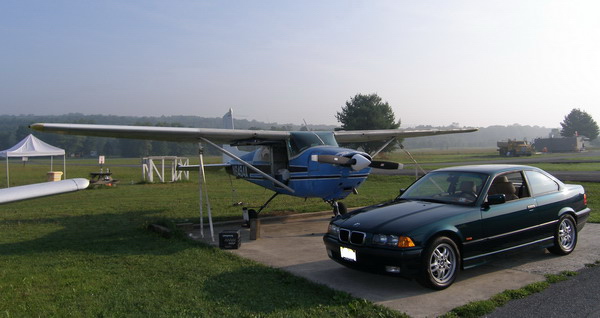 The next
step required that we remove the right seat, strap on some
parachutes and launch again -- this time to get a feel for the
aircraft with jumpers moving around in the cabin, do some
simulated jump runs and to learn the techniques required to open
and close the jump door. I strapped on a standard pilot reserve
rig, which consists of a single round canopy, while the DZO
strapped on a common sport rig (the same type that the jumpers
use) consisting of a main and a reserve canopy. This would serve
as our required safety gear, given that we'd be flying at
altitude mere inches from an open door in an aircraft with no
partition between the pilot seat and the door.
The next
step required that we remove the right seat, strap on some
parachutes and launch again -- this time to get a feel for the
aircraft with jumpers moving around in the cabin, do some
simulated jump runs and to learn the techniques required to open
and close the jump door. I strapped on a standard pilot reserve
rig, which consists of a single round canopy, while the DZO
strapped on a common sport rig (the same type that the jumpers
use) consisting of a main and a reserve canopy. This would serve
as our required safety gear, given that we'd be flying at
altitude mere inches from an open door in an aircraft with no
partition between the pilot seat and the door.
We soon launched again, and this time conducted the first of several simulated jump runs. On the first, we climbed to 4000 feet with the DZO peering out the jump door window. The process is called "spotting" and is what jumpers do to verify the aircraft is headed for the optimum upwind drop point. He had me slow the aircraft to 80MPH and maintain altitude while I flew the aircraft precisely down the runway centerline. The obvious goal here was to test my ability to perform what was effectively a ground reference maneuver at a relatively high altitude. I held the centerline well enough, but little did I know at the time how much more challenging the maneuver would be at nearly three times that altitude....in less than optimum visibility...with clouds often obscuring the target references (oh, and did I mention? No GPS).
At the end of the runway we broke it off and flew a modified pattern (a racetrack pattern, actually) back for another run. This time, with the DZO mere inches from the door, I set up 80 MPH before he opened the door. The jump door on the 182 is essentially a regular door remounted such that it is hinged at the top rather than the front side. As you may imagine this is required because the force of the slipstream would otherwise tend to close the door and make it exceptionally difficult to exit the aircraft safely. The jump door can be latched to the underside of the wing and released via a pull-type release near the right side "OJ Can" vent in the root of the wing, but for this run we just let the door "fly" open in its natural position floating about 45 degrees from the vertical.
As you may imagine, with the door trailing open it's not possible for the pilot to reach the door handle to pull the door closed (the pilot is, after all, belted in and wearing a parachute). So, how do jump pilots close the door after the jumpers are gone? They add a bit of left rudder, which partially blocks the slipstream on the right side of the aircraft and reduces the high pressure under the root of the wing so the door falls down to about a 15 degree angle -- close enough for the pilot to reach over, grab the handle, pull the door closed and twist the handle to lock it. So, that's basically what I did on the second run. Open the door. Close the door. Open the door. Close the door. Sounds pretty simple, and it is. But it's only one small thing the jump pilot needs to manage. For example, communications.
Ah, Errrr, Ah
It's been a long time since I learned to fly IFR, but I can certainly recall how tongue twisted I became trying to learn all the specialized phraseology. Heck, I can even remember my private pilot training vividly, and still cringe when I think about how I worked the radios back then. Now, after more than 1500 hours behind the yoke -- most of that under IFR -- I sound like a well-seasoned professional ...except when I'm trying to learn a bit of new phraseology like that required to properly execute a safe and effective jump run to 10000 feet AGL.
Jump pilots must coordinate jump runs with ATC per 14 CFR Part 105. That sounds easy in concept, until you understand how airspace is divided into sectors with both horizontal and vertical boundaries. While pilots flying low-performance jump aircraft such as the 182 stay within a few miles of the dropzone and usually don't have to worry much about the horizontal sector boundaries, all jump pilots routinely deal with the vertical boundaries.
In the US, if there's an approach facility nearby, they usually own the airspace up to 8000 feet AGL, and the regional Center owns sectors above that. That means in addition to working local traffic (yes, even at 10000 feet), you have to talk to the approach facility on the way up. And, if the approach facility can't work a hand-off or point-out with Center, you'll have to "cancel" with the approach facility, call up Center and talk to them directly. Of course, that doesn't leave you off the hook with regard to the approach facility -- even if you're talking to center, squawking a code they gave you, the approach facility expects you to give them a few standard calls to keep them apprised of the jump activity. Remember that while the jump plane remains at 10000 feet, once the skydivers leave the aircraft they're traversing those sector boundaries (quickly, I might add) and all controllers that have responsibility for the affected airspace need to know what's going on.
Ever wonder how controllers manage to work multiple frequencies during so-called "slow" traffic periods? Yea, I did too, until I had to learn to coordinate jump activities on three frequencies simultaneously -- using a single radio. It's not easy, primarily because time is of the essence. In the first 10 seconds of a jump, a skydiver falls about 1000 feet. After that, they fall about 1000 feet every six seconds (!). The jump pilot needs to announce several things in quick succession on all relevant frequencies to provide the notice necessary to protect both the jumpers and any aircraft that may be flying in the vicinity.
Free Jump, Anyone? ANYONE???
After the simulated jump runs were complete, we landed to find some victims...ahem...I mean, jumpers willing to heave themselves from an airplane commanded by this newbie jump pilot. Fortunately, the DZO managed to bribe three guys to commit to the task with the promise of a free jump. One of the crazy people turned out to be the dropzone's chief skydiving instructor, DZO's right-hand man, and accomplished jump pilot. The plan was for him to wear a headset to monitor my communications, give me tips as the jump run progressed, then remove the headset and jump out, leaving me all alone to descend and land the airplane.
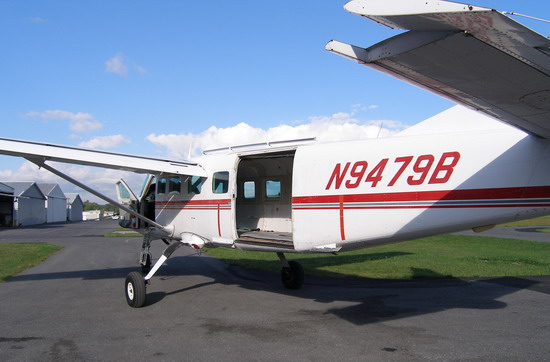 The
jumpers piled into the airplane while I started up and headed for
the runway. Even with three jumpers aboard, the little "182 that
could" managed 1200 FPM off the deck. I managed to spiral up over
the airport, call New York Center to let them know we'd be
jumping from 10000 feet. As I climbed to our target altitude of
10500 feet, the rate of climb tapered to around 600 FPM. New York
pointed out some airline traffic holding on the arrival routes
into the New York "Big Three" airports and came back with a
request.
The
jumpers piled into the airplane while I started up and headed for
the runway. Even with three jumpers aboard, the little "182 that
could" managed 1200 FPM off the deck. I managed to spiral up over
the airport, call New York Center to let them know we'd be
jumping from 10000 feet. As I climbed to our target altitude of
10500 feet, the rate of climb tapered to around 600 FPM. New York
pointed out some airline traffic holding on the arrival routes
into the New York "Big Three" airports and came back with a
request.
"Skylane 94A, notify 1 minute prior to jumpers away."
"Wilco, Skylane 94A", I replied tersely.
At 10000 feet MSL, I turned inbound toward the "spot" and began my first jump run.
"New York Center, Skylane 94A is one minute prior", I advised. As we reached altitude, the instructor said "Good luck", removed his headset, and then opened the jump door. Oddly enough, I found myself pretty relaxed at this point. I remember thinking that it had everything to do with the fact that I wasn't jumping this time -- all I had to do was keep the aircraft flying at target altitude, airspeed, and heading until the jumpers dropped, make a few radio calls, and then get it on the ground in one piece.
As the jumpers filed out, the last one patted me on the back, gave me the thumbs up, smiled and yelled "Thanks for the ride!", and promptly threw himself out of my perfectly good airplane. The time-worn wisdom of "Aviate, Navigate, Communicate" rang through my head at this point, so I stabbed a bit of left rudder to bring down the door, reached over and closed it, and then calmly depressed the PTT switch and said "New York, Skylane 94A, Jumpers Away, Descending". New York came back with the simple acknowledgement "Skylane 94A, roger".
I then hit the flip-flop button the radio and called local traffic: "East Stroudsburg traffic, Jumpers away from 10500, skydivers in the air over East Stroudsburg, use caution". About a minute later, after I knew the jumpers had open ed their canopies ("pulled" in jumper parlance), I made another call: "East Stroudsburg traffic, Skydivers in the air, look for canopies over over East Stroudsburg, use caution". I then let New York go, and proceeded to self announce my arrival into the pattern, pointing out that "jumpers are on the ground".
After I landed, I pondered what a cool thing I'd just done and taxiied in with a bit of a grin. The DZO asked me if I wanted to do another run, or if I felt comfortable enough. I told him "Na, that was cool...I feel good about everything. Communications might need a bit of work and I don't know the airplane really well yet, but I'll pick that up over time". The DZO said, "Okay, but before you go, I want you to go up in the Caravan with our full-timer so you can get a sense of the process soup to nuts and see how he does things. The process of flying the run in the Caravan is different than the 182, but it will help your communications and general understanding."
Okay. Twist my arm.
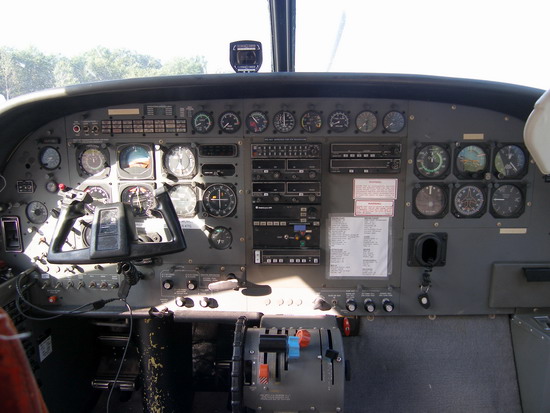 RPM x
Torque / 5252 = FUN!
RPM x
Torque / 5252 = FUN!
After I helped the full time Caravan pilot wrestle the right hand crew seat into the airplane, we hopped in, donned headsets, and began the startup sequence. A ground crew member attached the ground power cart to ensure the engine would spool up beyond the minimum 12% gas generator RPM (Ng) required to prevent a hot or hung start. We then flipped the battery switch and external power switches on, verified the emergency power lever was in Normal mode, and called the familiar "clear prop". The fuel boost and starter switches came next.
With the starter engaged and the turbine spooled up, the prop began to turn slowly. In less than 10 seconds we noted Ng stabilize at around 18% -- good enough to proceed with the ignition sequence. Soon after we confirmed oil pressure rising, the fuel condition lever was moved to low idle. With fuel introduced to the igniters, the quiet whistle of the starter was replaced by a throaty roar of fuel burning and a dramatic acceleration of the engine to a nominal 52% Ng. All the while we closely watched the interstage turbine temperature (ITT) to ensure we didn't overtemp the very expen$ive engine. Once running smoothly at ground idle, we turned off the external power and starter switches, flipped the boost pump to normal, gave the "disconnect" hand signal to the ground crew, and turned on our avionics power to light up the stack.
Since turbine engines are thirsty on the ground -- the 675SHP PT6A-114A being no exception -- we wasted no time in preparing the aircraft for flight. Brakes released, we swiftly taxiied over to the waiting group of skydivers and I turned around to watch them pile into the aircraft in less than 30 seconds. With everyone onboard, we restarted our taxi toward the runway, performed a before takeoff check, backtaxiied into position to leverage all of the 3000 feet of runway available, and lined up on the centerline before advancing the power lever to the proper takeoff torque setting.
The airplane rapidly accelerated to rotation of 83 KIAS and lifted off quickly considering that we were carrying a full load. Aside from the 1400 FPM initial climb rate and the occasional nudge on the power lever to keep the engine producing maximum power as defined today by the maximum continuous temperature limit, the climb itself was uneventful. We soon made the call to New York Center to inform them of our intention to climb to 14500 with jumpers and passing 12000 feet began our turn inbound. Some clouds briefly obscured the dropzone, so we went around for another pass, but the second time around managed to flip the "jump" light to green. On cue, the divers filed out of the door. Just after the last jumper left, we racked the airplane over into a 60 degree bank to watch the divers drop away from the aircraft. An interesting perspective to say the least.
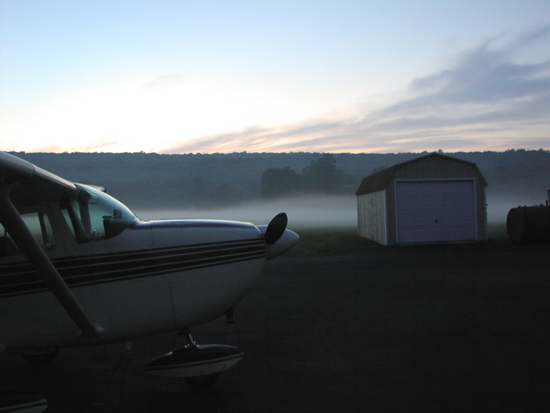 Then the REAL fun started as we pulled the power lever
to idle, let the nose slice through the horizon to a pitch that
would hold our maximum door open speed of 155KIAS, and watched
the VSI peg down at more than 3000 FPM. I cleared my ears a
couple times on our way down, while we both craned our necks
looking for open canopies and altered our flight path to remain
well clear of the descending jumpers. We arrived on base leg with
altitude and speed I thought for sure would stay with us right
through the flare, but I quickly discovered how much drag that
big prop generates at low pitch. While we did arrive at the
threshold at over 100KIAS and were eating up runway quickly, we
soon touched down and put the prop into beta for some serious
deceleration -- we found ourselves at taxi speed in less than
1000 feet, and we didn't use any reverse. Once back on the ramp
we let the engine idle below a nominal temperature for a bit over
a minute before we pulled the fuel condition lever to cutoff and
watched the engine decelerate to a stop.
Then the REAL fun started as we pulled the power lever
to idle, let the nose slice through the horizon to a pitch that
would hold our maximum door open speed of 155KIAS, and watched
the VSI peg down at more than 3000 FPM. I cleared my ears a
couple times on our way down, while we both craned our necks
looking for open canopies and altered our flight path to remain
well clear of the descending jumpers. We arrived on base leg with
altitude and speed I thought for sure would stay with us right
through the flare, but I quickly discovered how much drag that
big prop generates at low pitch. While we did arrive at the
threshold at over 100KIAS and were eating up runway quickly, we
soon touched down and put the prop into beta for some serious
deceleration -- we found ourselves at taxi speed in less than
1000 feet, and we didn't use any reverse. Once back on the ramp
we let the engine idle below a nominal temperature for a bit over
a minute before we pulled the fuel condition lever to cutoff and
watched the engine decelerate to a stop.
As the sun headed for the horizon and a warm afterglow formed over the ridge line to the west, I stuck around to help the pilot put the Caravan to bed for the night and chatted with him about commercial flying. I then said my goodbyes and thanks to everyone involved, hopped in the 172 and performed a relatively sedate takeoff enroute to home base. On the way home, I couldn't help but reflect on this great day. First of all it was my birthday and I was out of the office -- in other words, a good day to start. I topped it off with my first jump run as PIC, my first time in the cockpit of a turbine aircraft, my fastest climb, and finally, my highest altitude. All in all, suitable birthday gifts for my 36th year on the earth and 19th year as a pilot. But of course, this was just the beginning of my journey as a jump pilot. The real work was slated for the following weekend -- my first time providing commercial service to my fellow skydivers.



